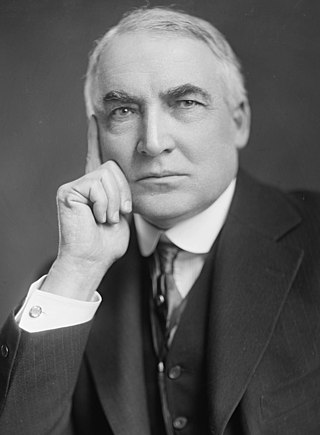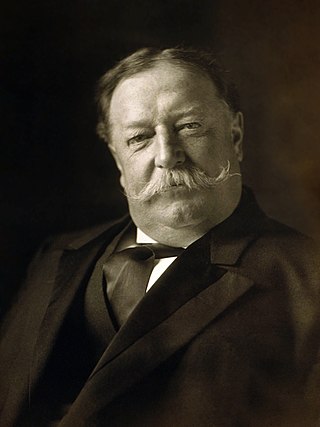The presidency of Woodrow Wilson began on March 4, 1913, when Woodrow Wilson was inaugurated as the 28th president of the United States, and ended on March 4, 1921.
The presidency of Woodrow Wilson began on March 4, 1913, when Woodrow Wilson was inaugurated as the 28th president of the United States, and ended on March 4, 1921.

Warren Gamaliel Harding was the 29th president of the United States, serving from 1921 until his death in 1923. A member of the Republican Party, he was one of the most popular sitting U.S. presidents while in office. After his death, a number of scandals were exposed, including Teapot Dome, as well as an extramarital affair with Nan Britton, which tarnished his reputation.

William Howard Taft was an American politician and lawyer who was the 27th president of the United States, serving from 1909 to 1913, and the tenth chief justice of the United States, serving from 1921 to 1930, the only person to have held both offices. Taft was elected president in 1908, the chosen successor of Theodore Roosevelt, but was defeated for reelection in 1912 by Woodrow Wilson after Roosevelt split the Republican vote by running as a third-party candidate. In 1921, President Warren G. Harding appointed Taft to be chief justice, a position he held until a month before his death.

Thomas Woodrow Wilson was an American politician and academic who served as the 28th president of the United States from 1913 to 1921. He was a progressive Democrat who previously served as the governor of New Jersey from 1911 to 1913 and as the president of Princeton University from 1902 to 1910. As president, Wilson changed the nation's economic policies and led the United States into World War I. He was the leading architect of the League of Nations, and his progressive stance on foreign policy came to be known as Wilsonianism.

The 1920 United States presidential election was the 34th quadrennial presidential election, held on Tuesday, November 2, 1920. In the first election held after the end of the First World War, and the first election after the ratification of the Nineteenth Amendment which gave equal votes to men and women, Republican senator Warren G. Harding of Ohio defeated Democratic governor James M. Cox of Ohio. It was the third presidential election in which both major party candidates were registered in the same home state. The others have been in 1860, 1904, 1940, 1944, and 2016, and the last time that the state was not New York. It was the first presidential election to have its results broadcast by radio.

This section of the timeline of United States history concern events from 1900 to 1929.

The United States involvement in the Mexican Revolution was varied and seemingly contradictory, first supporting and then repudiating Mexican regimes during the period 1910–1920. For both economic and political reasons, the U.S. government generally supported those who occupied the seats of power, but could withhold official recognition. The U.S. supported the regime of Porfirio Díaz after initially withholding recognition since he came to power by coup. In 1909, Díaz and U.S. President Taft met in Ciudad Juárez, across the border from El Paso, Texas. Prior to Woodrow Wilson's inauguration on March 4, 1913, the U.S. Government focused on just warning the Mexican military that decisive action from the U.S. military would take place if lives and property of U.S. nationals living in the country were endangered. President William Howard Taft sent more troops to the US-Mexico border but did not allow them to intervene directly in the conflict, a move which Congress opposed. Twice during the Revolution, the U.S. sent troops into Mexico, to occupy Veracruz in 1914 and to northern Mexico in 1916 in a failed attempt to capture Pancho Villa. U.S. foreign policy toward Latin America was to assume the region was the sphere of influence of the U.S., articulated in the Monroe Doctrine. However the U.S. role in the Mexican Revolution has been exaggerated. It did not directly intervene in the Mexican Revolution in a sustained manner.

Woodrow Wilson's tenure as the 28th president of the United States lasted from March 4, 1913, until March 4, 1921. He was largely incapacitated the last year and a half. He became president after winning the 1912 election. Wilson was a Democrat who previously served as governor of New Jersey. He gained a large majority in the electoral vote and a 42% plurality of the popular vote in a four-candidate field. Wilson was re-elected in 1916 by a narrow margin. Despite his New Jersey base, most Southern leaders worked with him as a fellow Southerner. He was succeeded by Republican Warren Harding, who won the 1920 election.

The presidency of William Howard Taft began on March 4, 1909, when William Howard Taft was inaugurated as 27th president of the United States, and ended on March 4, 1913. Taft was a Republican from Ohio. The protégé and chosen successor of President Theodore Roosevelt, he took office after easily defeating Democrat William Jennings Bryan in the 1908 presidential election. His presidency ended with his landslide defeat in the 1912 election by Democrat Woodrow Wilson, after one term in office.

Warren G. Harding's tenure as the 29th president of the United States lasted from March 4, 1921, until his death on August 2, 1923. Harding presided over the country in the aftermath of World War I. A Republican from Ohio, Harding held office during a period in American political history from the mid-1890s to 1932 that was generally dominated by his party. He died of an apparent heart attack and was succeeded by Vice President Calvin Coolidge.

The inauguration of Warren G. Harding as the 29th president of the United States was held on Friday, March 4, 1921, at the East Portico of the United States Capitol in Washington, D.C. This was the 34th inauguration and marked the commencement of Warren G. Harding's only term as president and of Calvin Coolidge's only term as vice president. Harding died 2 years, 151 days into this term, and Coolidge succeeded to the presidency.
The presidency of Dwight D. Eisenhower began on January 20, 1953, when Dwight D. Eisenhower was inaugurated as the 34th president of the United States, and ended on January 20, 1961.
The presidency of Harry S. Truman began on April 12, 1945, when Harry S. Truman became the 33rd president upon the death of Franklin D. Roosevelt, and ended on January 20, 1953.
The presidency of Herbert Hoover began on March 4, 1929, when Herbert Hoover was inaugurated as the 31st president of the United States, and ended on March 4, 1933.
The presidency of Calvin Coolidge began on August 2, 1923, when Calvin Coolidge became the 30th president of the United States upon the sudden death of Warren G. Harding, and ended on March 4, 1929.
Warren G. Harding was inaugurated as the 29th president of the United States on March 4, 1921, and served as president until his death on August 2, 1923, 881 days later. During his presidency, he organized international disarmament agreements, addressed major labor disputes, enacted legislation and regulations pertaining to veterans' rights, and traveled west to visit Alaska.
The following is a timeline of the presidency of Lyndon B. Johnson from January 1, 1968, to January 20, 1969.

The following is a timeline of the presidency of Richard Nixon from January 1, 1970, to December 31, 1970.

The history of U.S. foreign policy from 1913–1933 covers the foreign policy of the United States during World War I and much of the Interwar period. The administrations of Presidents Woodrow Wilson, Warren G. Harding, Calvin Coolidge, and Herbert Hoover successively handled U.S. foreign policy during this period.
The presidency of George Washington began on April 30, 1789, when George Washington was inaugurated as the first president of the United States, and ended on March 4, 1797.
The presidency of William Howard Taft began on March 4, 1909, when William Howard Taft was inaugurated the 27th president of the United States and ended on March 4, 1913.